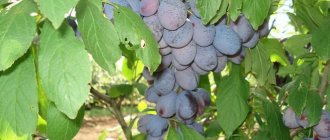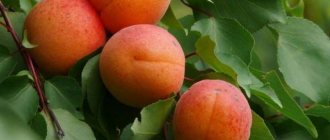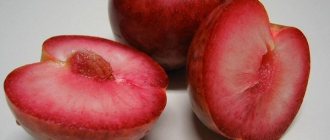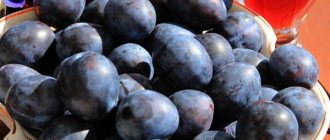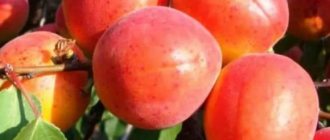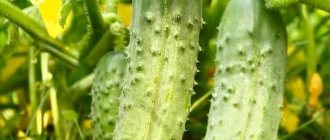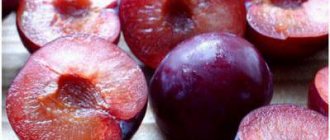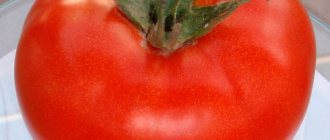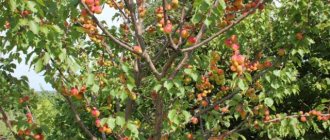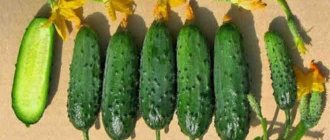The most unusual of all hybrids - sharafuga (or nectacotum) - has recently become increasingly popular. It is distinguished by frost resistance, early fruiting and unusual taste of the fruit. Read more about the “strange” fruit, its characteristics, types, main stages of planting and caring for a tree.
variety "Sharafuga" - a hybrid of plum + apricot + peach
hybrid "Sharafuga" has increased resistance to disease
Depending on the variety, “Sharafuga” is purple or orange.
What is sharafuga?
This hybrid has three heat-loving “parents” - peach, apricot and plum. But, unlike them, the plant itself is frost-resistant and grows in cooler conditions. It is grown both in the south and in temperate climates.
Externally, the tree looks like an ordinary plum - with the same leaves and thorns. The shape and size of the fruit are inherited from the apricot; when the pit has a peculiar pattern from the peach, it is easily separated from the pulp.
The taste of the fruit depends on its ripeness. Unripe specimens resemble plum flavor, while mature ones resemble apricot, the flesh is sweet or sour, juicy and pleasant.
Varieties of apricot hybrids
To date, dozens of different new varieties of these fruits have been developed that have original taste qualities.
Sharafuga (sharofuga)
For example, a hybrid of apricot and plum is called sharafuga. It is a hybrid apricot that is dark red in color and the size of a medium apple. Its taste is a cross between peach, plum and apricot. Note that growing sharafuga on a personal plot is not particularly difficult.
Excellent frost resistance somewhat simplifies the planting and subsequent cultivation of trees in the garden. Moreover, such plantings begin to bear fruit already in the fifth year of their life. Maximum yield is observed in the eighth to tenth year of life. The grown crop has excellent shelf life, and the fruits of sharafuga can be used to prepare various jams, compotes and aromatic preserves.
Note that today there are several varieties of this hybrid, which may differ in their color and size of the fruit. Just remember that you need to choose high-quality planting material, which is best purchased in the appropriate nurseries.
A hybrid of peach and apricot is popular among gardeners. Due to its excellent taste and ease of planting care, this fruit is now widely used among amateur gardeners. This fruit has dominant characteristics of apricot, but the tree itself is distinguished by excellent winter hardiness, which greatly simplifies its cultivation in central Russia. The grown crop has juicy pulp with a sweet and sour taste. Such fruits are used fresh and are excellent for subsequent processing.
Nectarine
Many biologists are still arguing about what nectarine actually is. Some argue that this is one of the subspecies of peach, while others are inclined to the theory that nectarine was obtained by crossing a plum and a peach.
Nectarine has the appearance of a small peach, which gives reason to believe that this variety is a mixture with plum. However, recent research has established that nectarine is a subspecies of the common peach.
The skin of this fruit is smooth without the characteristic pimples and hairs. This smooth fruit has an original, slightly sour taste. Nectarine is used to make various jams and preserves.
This plant is resistant to low temperatures, which makes it possible to successfully grow it even in the not too hot climate of central Russia.
Picherin
Quite often in our gardens there is such a fruit tree as picerin, which is a hybrid of nectarine and peach. These fruits, which are the size of a large plum, have brightly colored, juicy pulp with a great taste.
Let us only note that Picherin still has the characteristics of basic trees, so this fruit crop does not have good frost resistance. The gardener will need to properly insulate young trees for the first few years after planting, which will ensure their survival after a cold winter.
The cultivation of peach and plum hybrids shows excellent results. Some people call such trees nectarines, but this is still not true. Nectarine is a separate subspecies of apricots.
The hybrid of peach and plum has a subtle sweet and sour taste, and the tree itself is distinguished by excellent productivity and ease of care. We can recommend such hybrids even to novice gardeners, who can easily get an excellent harvest in their garden plot even with the simplest care of fruit trees.
Black apricot
A hybrid of cherry plum and apricot is of great interest for cultivation in private plots. Quite often such fruits are called black apricots. This fruit inherited from the cherry plum its late flowering and slow development in the spring. This makes it possible to protect the plantings from late frosts in the spring.
This hybrid is also characterized by crop stability and regular fruiting. Excellent frost resistance makes it possible to successfully grow such fruits in the Moscow region and central Russia. Black apricot is propagated by seed, root shoots, or by grafting from varietal trees.
The trees themselves of this hybrid of apricot and cherry plum are of average height, which vaguely resembles a large bush. The fruits, when ripe, initially turn green, but when fully ripe, acquire a characteristic dark brown color.
The harvested crop has excellent taste characteristics, it can be easily stored for a long time, and one tree can produce about ten kilograms of delicious fruit. This black apricot makes excellent preserves, jams and delicious tonic compotes.
Description
What does sharafuga look like? This is a compact tree with a spreading crown of medium density. Every year the length of the shoots increases by 50-70 cm. Outwardly, it looks more like a plum. There are thorns on the branches. The leaves are curled, just like a peach.
The fruits are large (6-7 cm), shaped more like apricots. Depending on the variety, the skin is purple or orange. The apricot aroma is subtle. The fruits do not fall off, ripen in late August - early September, and have universal significance. They are consumed fresh, and compotes, jams and preserves are also prepared from them. They tolerate transportation well over long distances.
Types of sharafuga
This hybrid is very poorly represented on the market. From trusted sellers you can purchase only two types, which differ in the color of the fruit - bluish-violet and yellow. Purple fruits have red flesh with yellow veins and taste more like a sour plum. Yellow fruits, with orange spots scattered on the skin, are sweeter and closer to apricot, although the structure is still the same as plum.
In America, where sharafuga was actually bred, there are the following varieties:
- Bella Cerise and Bella Royale - for commercial sales;
- Bella Gold - a variety exclusively for home cultivation with yellow fruits;
- Velvet Sunrise - with purple.
Advantages and disadvantages
The “advantages” of culture are:
- frost resistance;
- high productivity;
- resistance to diseases and pests;
- excellent appearance and taste of the fruit;
- their transportability.
But there are also many disadvantages:
- the hybrid does not produce seeds;
- prefers only fertile soils; fertilizing when growing sharafuga is a necessary procedure;
- seed material is more expensive than conventional crops;
- It is imperative to monitor soil moisture;
- For better fruit set, it is necessary to plant a plum or apricot near the sharafuga, the flowering of which occurs at the same time as it. Shrafuga usually blooms together with pear, so early varieties are selected.
Hybrid of plum and apricot
Modern world markets of fruit trees and shrubs offer buyers a huge list of new and traditional varieties of fruit crops, which are constantly updated with new varieties and their hybrids. Fruit plant hybrids are obtained by crossing common fruit and berry species. For example, the aromatic and tasty yoshta was obtained by crossing gooseberries and black currants, and the “progenitors” of the raspberry are raspberries and blackberries. The range of new products includes a plum crossed with an apricot, known under the abbreviated name abrisliva.
Landing Features
Experts recommend purchasing seedlings from trusted nurseries; quite often, other plum and apricot hybrids are sold under the guise of sharafuga.
Primary requirements
As mentioned above, sharafuga grows in the middle climate zone. If in the south it is planted both in autumn and spring, then in the central, northern regions with a colder climate, the best solution is spring planting.
The place for the seedling is chosen to be sunny, flat or slightly elevated. The main thing is that it is protected from cold winds. Cold air and dampness should not stagnate in the area. Planting in lowlands leads to the development of fungal diseases.
The optimal soil structure for the crop is air- and moisture-proof, fertile. If the soil on the site is acidic, then lime it first. Add 300 g of slaked lime per 1 sq. m.
They prepare it before planting in advance - in the fall. Having decided on the place to plant the seedling, the soil is dug up deeply and at the same time several buckets of humus and mineral fertilizers are added - 35 g of potassium and 70 g of superphosphate.
Instructions for planting (step by step)
In order to grow sharafuga, adhere to the following instructions:
- In the spring, a hole measuring 80x80x80 cm is dug within 2-3 weeks;
- Drainage made of broken bricks or pebbles of medium fraction is laid at the bottom to prevent stagnation of water;
- Drive a stake so that it rises 50 cm above ground level;
- Fill the fertile soil with a mound. It may consist of peat, humus and prepared soil from the pit, taken in equal quantities;
- The plant is placed on the mound and the roots are straightened;
- They fill up the hole and compact the earth;
- The trunk of the seedling is tied to a peg;
- Water generously;
- The tree trunk circle is mulched with organic matter - rotted manure, hay, and mown grass. This agricultural technique helps reduce moisture evaporation, improve the structure of the soil, and “saturate” it with nutrients.
Apricot plum: variety description, photos, reviews
Apricot plum is a fast-growing hybrid of apricot and plum. A variety with a rich history has become a favorite of many summer residents and commercial gardeners. Unpretentiousness in care, excellent taste of fruits, high frost resistance - these are significant advantages of the Apricot plum over other fruit crops.
History of variety selection
The history of the variety begins in the last century. For 30 years, US breeder Floyd Zeiger conducted experiments to obtain a new variety. Crossing a plum with an apricot gave the result in the form of a hybrid - apricot plum.
Description of Apricot plum
Apricot plum has several subspecies:
Each variety is resistant to harsh winters. Their cultivation area extends to the northern and southern regions.
The trees of the hybrid are not tall - no more than 2.5 m. The crown is in many ways similar to a plum tree. Very often it has a drooping shape with medium-density foliage. The plant blooms with white flowers in early April. The fruits ripen by July-August.
Each variety of Apricot plum has common features in the description of the fruit:
- Large size. One fruit weighs from 30 to 70 g.
- Oval shaped plums.
- Green-pink, yellow or purple skin with a waxy coating.
- The fruit pulp is particularly juicy and dense.
Characteristics of the variety
The characteristics of the Apricot plum variety affect the abundance of the harvest and the health of the hybrid. They must be taken into account when choosing a planting site, care procedures, and preventive measures.
Drought resistance, frost resistance
The variety is characterized by a high level of frost resistance. The hybrid can withstand significant temperature drops. It also tolerates warm climates and hot summers well.
Advice! Apricot plum does not like winter thaws. You should pay close attention to the variety during this period.
Apricot hybrid is self-fertile. To improve the harvest, you can plant pollinators nearby - trees of similar varieties:
- Altanta;
- Renklod Kolkhozny;
- Plum Michurinskaya, others.
Productivity and fruiting
Apricot plum is a fast-growing hybrid. Fruiting occurs 2-3 years after planting. The yield increases as the variety matures. Blooms in April. Ripe fruits are picked in August-September. Up to 50 kg of fruits are collected from one tree.
Important! The plum will ripen in 7-10 days. Weather conditions may adjust this period. The hybrid must be monitored so as not to miss the moment of ripening.
Scope of drains
The sweet taste of plums makes them an excellent dessert. Jams, preserves, compotes, and juice are made from them.
Resistance to diseases and pests
The hybrid of plum and apricot is practically not susceptible to disease and is not affected by insects. It is necessary to carry out preventive measures to completely avoid harmful effects.
Advantages and disadvantages of the variety
Numerous advantages of the variety make the Apricot diploid hybrid popular among other garden crops:
- High level of frost resistance. This allows the variety to be planted in the northern regions.
- Precociousness. The plum bears its first harvest a couple of years after planting. The fruits ripen in mid-summer.
- Large fruits. The weight of one plum is up to 70 g. The taste is dessert. This makes the variety attractive for private and commercial gardening.
- Fruits are sources of many useful substances and vitamins.
Apricot plum has distinctive features:
- The pulp of the fruit contains a special enzyme. It provokes the development of stomach ulcers. You should not overuse plums on an empty stomach.
- Fruits do not retain their presentation during transportation.
- Plums cannot be stored for long periods of time. The picked ripe fruit must be consumed as soon as possible.
Landing Features
Planting a plum hybrid is not a labor-intensive process. It is enough to choose the right place in the garden plot and follow the steps of planting a young seedling.
Recommended timing
Work with Apricot plum seedlings is carried out in early spring. Planting during this period ensures maximum rooting of the plant. Before the onset of cold weather, the young tree will have time to get stronger and get used to the local climate. In regions with mild, warm weather conditions, planting can be done in the fall.
Choosing a suitable location
Choosing a place for a hybrid seedling is a responsible task. It must meet certain criteria:
- Plentiful lighting throughout the day.
- No drafts or wind blown.
- The soil for planting must be nutritious and airtight.
Important! The soil should not be overly acidic. A lime solution will correct this deficiency; it should be added to the soil before planting plums.
Tall plants with spreading crowns should not be planted nearby. They will create additional shade for a short tree, which can affect the quality of the fruit. Similar varieties, apple trees, and evergreen shrubs will have a beneficial effect on planting.
Selection and preparation of planting material
The choice of planting materials should be approached responsibly and in advance. A set of gardening tools must include:
- A shovel for holes.
- Rake for loosening.
- Wooden stake, rope for fastening and fixing the seedling.
- Drainage.
- Fertilizers.
- Water for irrigation.
Landing algorithm
Planting the Apricot plum takes place in several stages. Each of them must be performed in accordance with the recommendations presented:
- Preparing the holes. Using a shovel, holes are formed. Depth – 80 cm, diameter – 80 cm.
- Drainage layer. A layer of brick and stone is laid out at the bottom of the planting hole.
- Feeding. After drainage, organic fertilizers, potash fertilizers, and superphosphate are poured into the pit.
- Planting a seedling. Its roots spread freely inside the hole. The cuttings are covered with earth, watered, and compacted.
- Additional reinforcement. The trunk of a young tree is tied with a soft rope to a wooden peg.
- An earthen roller is formed around the plum trunk. It will prevent the accumulation of liquid in the roots of the plant.
Aftercare for plums
When caring for the Apricot plum, it is necessary to take into account some nuances. They affect the health of the planting and a bountiful harvest:
- Watering. The hybrid does not like stagnant liquid. It is important to monitor the groundwater level. After each watering, the soil under the plant is thoroughly loosened.
- Formative pruning. To create a neat crown, the cutting of branches begins at the young tree.
- Feeding. It is carried out in three stages. Before flowering, nitrogen fertilizers are applied. Before fruit ripening, micro-feeding is carried out. In the fall, organic matter is added.
- Disease prevention. Regularly carry out preventive measures against diseases and pests. Cutting dry branches, destroying root shoots, and regularly cleaning the garden plot are mandatory procedures for maintaining plum immunity.
- Shelter for the winter. For a frost-resistant variety, it is enough to whiten the trunk with a solution of lime, cover the roots with pine needles and sawdust. In autumn, the soil under the plum tree is dug up.
Diseases and pests, control methods and prevention
| Disease/pest | Description | Control method/Prevention |
| Hole spot | Spots form on leaves, branches, and fruits. Subsequently they turn into holes. Leaves and fruits fall off. The branches are drying up | Before flowering, 2 weeks after it, the tree is treated with Bordeaux mixture. Affected areas must be completely destroyed |
| Coccomycosis | Red spots appear on the upper side of the leaf. The inside is covered with a white coating. Leaves fall, fruits dry up | Mandatory destruction of fallen leaves, branches, and fruits. The plum is sprayed with “Hom”, Bordeaux solution |
| Fruit mite | The foliage turns brown and falls off. The tree doesn't bloom | As a preventive measure, you should get rid of the old bark. In case of massive pest infestation, the plum is treated with chemical insecticides |
Conclusion
Apricot plum is a unique hybrid of two popular fruit varieties. He inherited the distinctive features of the two species. The variety is popular in the garden environment. Its large, sweet fruits are widely used in the preparation of delicious desserts. The unpretentious tree is grown by amateur summer residents and commercial gardeners.
Reviews
Kulagin Arseny, Voronezh
https://www.youtube.com/watch?v=C_Yn0q14p9s
I wanted to surprise my family with unusual fruits. It took me a long time to choose exactly what would suit our climatic conditions. I immediately liked the Apricot plum.
I prepared the planting site carefully: I chose a sunny area and built artificial protection from wind and drafts. Planting a seedling did not take much effort. The time spent on care is minimal. I didn’t expect to see the first harvest in two years. The fruits are tasty and large.
The children took a long time to guess: plum or apricot. I recommend this variety to all lovers of non-standard fruit trees.
Ivanova Marina, Tambov
I am an experienced summer resident. She planted many trees and harvested various crops. I prefer regular varieties, without any special features. For her anniversary, the children gave a plum sapling to Apricotova. I was skeptical. The tree is unusual. It requires approach, attention, and careful care.
Planted it in the sunniest place in the garden. I insulated it before winter. I didn't expect to survive. But not only did it not disappear, but three years later it gave us a wonderful harvest. I didn’t make any special efforts, I didn’t spend a lot of time on it.
Now this is my favorite variety.
Source: https://fermilon.ru/sad-i-ogorod/derevya/sliva-abrikosovaya.html
Agricultural technology
To get a harvest from a tree, care is organized, which consists of proper watering, timely application of fertilizers and soil care.
Watering the plant
The frequency of watering directly depends on weather conditions. If the spring turns out to be wet, then water it only during the hot period. Otherwise, watering is carried out several times in the spring.
It is better to water sharafuga, like plums, by sprinkling. Or dig a groove 15 cm deep in a circle at a distance of 0.5 m from the trunk, and pour 2-3 buckets of water into it per 1 square meter. m.
What, how and when to feed?
Feeding is an obligatory item in the agricultural technology of sharafuga. It is applied throughout the growing season.
In the spring, after the snow melts, they are fed with nitrogen fertilizers. In the summer, in the first half of June and the end of July, the tree is “fed” with potassium and nitrogen fertilizers for better fruit growth and faster ripening. Carry out 1-2 foliar sprayings with the same fertilizers.
Soil care
After watering or precipitation, the soil is loosened and mulched. If the garden is old, then dig up the soil under the trees using a fork and shovel. It is enough to dig around the trunk to a depth of 5-10 cm, the farther from it, the deeper the digging - up to 15 cm. The tree trunk circle is regularly cleared of weeds.
Other care and cultivation activities
Sharafuga grows quite quickly, so in early spring, before sap flow begins, all annual shoots are shortened by half. At the same time, sanitary pruning is carried out - dried, broken and diseased branches are cut out.
Preparing tools
High-quality pruning of apricot trees is impossible without the appropriate equipment. All tools must be well sharpened. To keep your garden knife sharp, you need to use a wet whetstone, which is excellent at removing sawdust. A dull pruner should be disassembled before use to sharpen the cutting blade. After collection, the tool must be checked for functionality. You can adjust the pruning shears through the tension nut: if the grip is too tight, then loosen it, if it is loose, tighten it.
To care for an apricot tree you need to have the following tools:
- Special grafting knife.
- Secateurs.
- Sharpening stone.
- A product for sealing cuts (for example, garden pitch).
- Strong twine for supporting branches and shoots.
Diseases, pests and protection
All hybrids are resistant to diseases and insects. Sharafuga only has a predisposition to leaf curl, inherited from peach.
But preventative measures are better to use. Whitewashing the trunk and skeletal branches with lime will help prevent sunburn and pests. The plant is whitened 2 times a year - in spring and autumn.
And also, in order not to provoke the appearance of pests in the fall, the tree trunk area is thoroughly cleaned of plant debris, fallen leaves and fruits. All collected natural waste is burned.
At the first signs of diseases or pests, folk remedies are used. Spray the tree with infusion of garlic or onion. If there is a large population of insects, you will have to use chemicals - insecticides, and if diseases develop - fungicides.
Rejuvenating an old apricot
If the gardener has not properly cared for the tree, then within five years the growth of new shoots will stop. But apricot has a good regenerative function - one rejuvenating pruning is enough for it to resume branch growth. With the arrival of autumn, the gardener must adhere to two basic rules:
- Identify the oldest branches or those that have already stopped bearing fruit. It is forbidden to remove all unnecessary shoots at once. For work you need to use a sharp saw.
- Among all the variety of branches you need to find the youngest ones. All shoots growing in a chaotic manner are cut down.
After such pruning, all nutrients will be directed to the development of the remaining branches and the formation of a good ovary. It is worth noting that old wood is not cut off immediately, as this can cause the death of the apricot.
The most unusual of all hybrids - sharafuga (or nectacotum) - has recently become increasingly popular. It is distinguished by frost resistance, early fruiting and unusual taste of the fruit. Read more about the “strange” fruit, its characteristics, types, main stages of planting and caring for a tree.
Harvesting, storage and processing
The harvest matures depending on the region. In warmer areas, the fruits ripen in August, in areas located further north - in early September. Since the fruits stick well to the tree, they are collected by hand. Don't shake the branches. When they hit the ground, they are damaged, which negatively affects their shelf life.
The fruits are perfect as a filling for pies; delicious compotes and amazing jams are made from them.
Reviews from gardeners
Since few people are familiar with the hybrid, reviews about it are quite contradictory:
★★★★★
Maxim, 35 years old, Moscow region. The first time with Sharafuga they cheated me, they sold me something I don’t understand.
I waited for several years for fruit to appear on it and waited. Complete disappointment. The fruits are small, the seed is not separated, the skin is purple, similar to the color of a plum, but the flesh is neither a plum, nor a peach, nor an apricot. The taste is incomprehensible. That year I ordered seedlings from a trusted website, and they all took root. I'm waiting for fruit again. ★★★★★
Olga, 42 years old, Krasnodar region. My husband is an experimenter.
Sharafuga did not pass him by, the name alone is worth it. I planted three of them. He carried them around like a sack. And scheduled fertilizers and watering. But, we must pay tribute, the seedlings took root well, did not get sick during all this time and there were no bugs on them. In the fourth year they saw fruit. Delicious, sweet. The children were taken for testing to another region, I thought we wouldn’t get there, but no, we got there fine, didn’t even get damaged. Hide
Add your review
Hybrid sharafuga is a real find for exotic lovers. If planted correctly and all care rules are followed, the tree will produce juicy fruits with an interesting taste.
0
0
Copy link
Other plum hybrids
In addition to the above hybrids, many amateur gardeners are interested in other hybrid crops that emerged from crossing plums and other stone fruits:
- Peach plum. This plum crossed with a peach has large, red-sided, honey-colored fruits. The taste of the fruit is sweet and sour with soft and juicy pulp. Growing peach plum has its own characteristics. The fact is that this hybrid is sterile, so for pollination it is necessary to plant pollinating trees nearby. For this reason, plums of the Hungarian, Mirabelle Nancy, and Renclod varieties are planted next to the hybrid. Peach plum begins to bear fruit six years after planting. A full and regular harvest can be harvested from a tree that has reached the age of 15 years.
- Plum crossed with cherry plum. In fruit tree markets you can find seedlings with the intriguing exotic name “Black Apricot”. This hybrid crosses apricot and cherry plum, known as a small variety of plum. A successful combination of positive “parental” qualities, such as tasty juicy “apricot” fruits with the consistency of cherry plum with a pleasant sourness, brought this variety to the first place in the ranking of hybrid stone fruit crops. The variety bears fruit regularly even in the most unfavorable growing conditions.
- Hybrid of apple and plum. Although breeding technologies are constantly developing, to date no hybrid of apple and plum has been created. Apple nectarine, which is a derivative of peach and apple, is often offered to customers under this name.
As can be seen from the review of hybrid fruit breeds, it is with plum that other stone fruit species can be crossed. As a result of such selection, interesting hybrid varieties with tasty, attractive-looking fruits appear.

